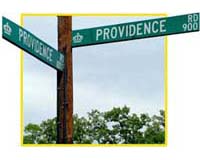Wilkinson Boulevard
When Wilkinson Made History
No one would ever mistake Wilkinson Boulevard for an historic district. Six lanes of traffic wend westward out of central Charlotte through a work-a-day world of warehouses, strip shopping centers and small businesses. Dilworth or Myers Park it ain’t.
But Wilkinson Boulevard has a surprisingly interesting history. The highway attracted statewide acclaim when it opened back in the 1920s. Its story demonstrates the deep links between banking, textiles and government that have long shaped Charlotte’s growth.
The tale starts with William Cook Wilkinson, a banker, mill owner and New South visionary. Born a tailor’s son in 1866, Wilkinson went to work at age 16 as office boy at Merchants and Farmers Bank in downtown Charlotte. In classic Horatio Alger fashion he worked his way up until, in 1919, he became president of the bank.
Wilkinson’s abilities won honors from fellow bankers, who elected him president of the North Carolina Banker’s Association and president of the National Bank division of the American Banker’s Association. Wrote the Charlotte Observer, “He was classed as one of the South’s most prominent bankers and one of Charlotte’s leaders, not only in the banking business, but in the industrial field.”
In the 1920s the South’s hottest industrial field was cotton manufacturing. The Carolina piedmont was surpassing old New England to become the textile making center of the United States. Before long Wilkinson was president of Elizabeth Mills on Charlotte’s west side and Lowell Mills just across the Catawba River in Gaston County, and sat on the board of directors of several other Gaston factories.
Difficulty in getting to those far-flung enterprises likely aroused Wilkinson’s interest in road-building.
North Carolina had virtually no paved roads as the ‘twenties dawned. Back in the 1890s Charlottean D.A. Tompkins had led a campaign that convinced some counties to invest in “macadam” roads of tight-packed gravel. But by 1920 that technology was sadly outmoded. Cars frequently sank to their axles in mud.
Wilkinson got himself appointed to the new state highway commission, which in 1921 was charged by Governor Cameron Morrison with spending $50 million from a “Good Roads” bond issue. It was the largest such investment by any Southern state.
Wilkinson made sure a top priority was a construction of a highway from Charlotte, the textile region’s banking city, straight to Gaston County, which held the piedmont’s largest concentration of textile factories.
When it opened about 1926, Wilkinson Boulevard was the first four-lane paved highway in all of North Carolina. A 40 foot swath of concrete with a 10 foot dirt shoulder on each side, the roadway was landscaped with grass, vines and shrubbery from Charlotte all the way to the Gaston County line. “The South’s finest highway,” the Observer called it, “a showplace of the South.”
Wilkinson Boulevard remained Charlotte’s western “front door” til the 1960s, when Interstate 85 supplanted it.
If you drive Wilkinson today, look for remnants of its heyday. Mr. Wilkinson’s Elizabeth Mills still stands, occupied by Radiator Specialty. You’ll pass the Bar-B-Q King drive-in and a Dairy Queen right out of the 1950s, and cross the World War One Memorial concrete bridge over the Catawba River.
But most of all, there’s the Wilkinson name and that route from Charlotte to Gastonia – reminders of the power of banking and textiles to shape our region.
— Tom Hanchett, Charlotte Observer, November 2000 – used with permission

Here’s a little history of just a few of Charlotte’s streets:
Sharon Road
Wilkinson Blvd
Central Avenue
Presbyterian Streets
Barringer Drive
